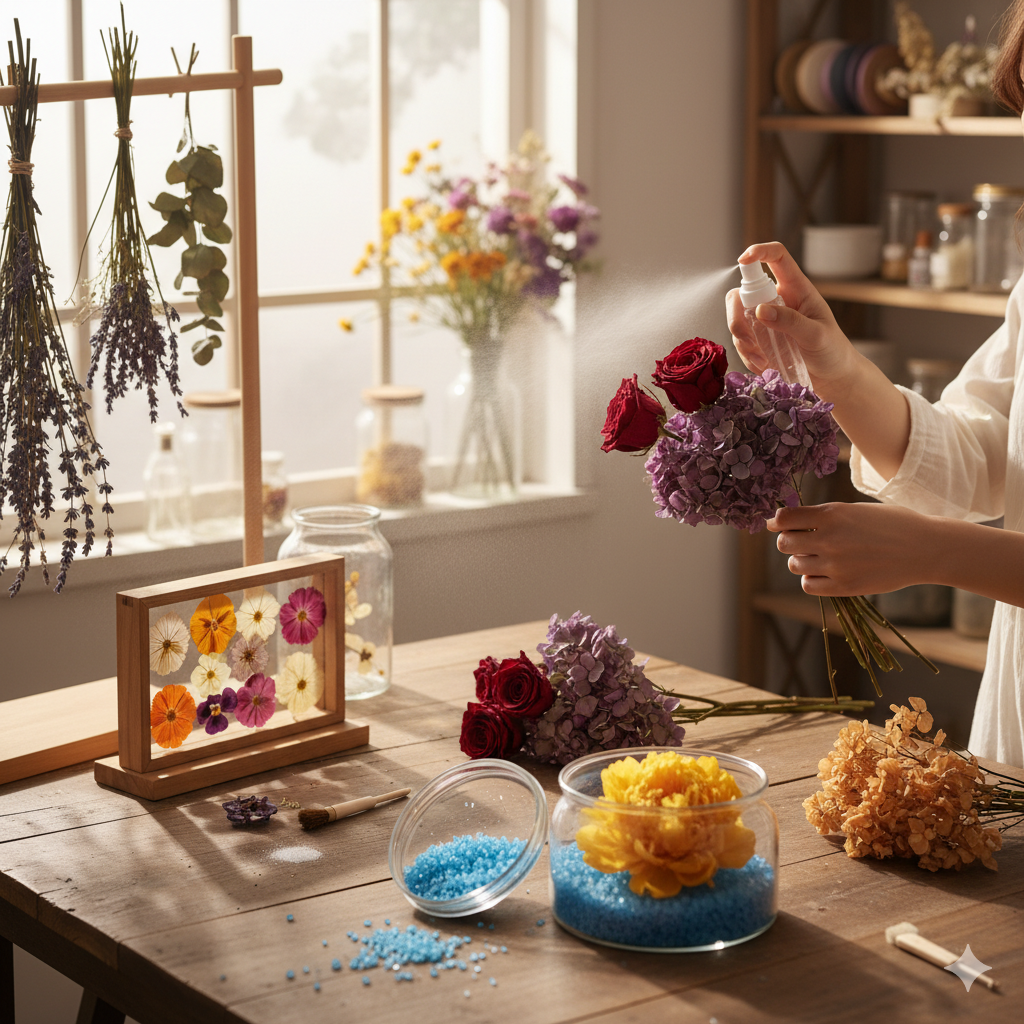Capturing the Ephemeral Beauty
Flowers capture fleeting moments—from weddings to garden harvests. But their beauty fades quickly unless preserved correctly. Drying flowers isn’t just about removing moisture; it’s about keeping their shape, color, and quality intact over time.
This guide covers:
-
How to prepare flowers before drying
-
Step-by-step drying methods (traditional and advanced)
-
Best practices for long-term storage
-
Pro tips to prevent fading, mold, and damage
Step 1: Prepare Your Flowers Before Drying
The right preparation ensures colors and shapes are maintained.
-
Bloom Stage: Pick just before full bloom. Too late = petals drop. Too early = buds won’t open.
-
Timing: Harvest late morning after dew has dried.
-
Condition: Choose blemish-free, firm flowers.
-
Stem Prep: Strip excess foliage; trim stems to desired length.
-
Dry Surface: Pat dry with a soft paper towel if needed.
Step 2: Best Flower Drying Methods
Each technique produces a slightly different look and level of color preservation.
1. Silica Gel Drying (Best for Shape + Vibrant Color)
-
Pour 1 inch of silica gel into an airtight container.
-
Place flowers face-up on the gel.
-
Gently cover with more crystals until submerged.
-
Seal and leave 5–10 days, or microwave briefly on low for faster results.
-
Brush off crystals gently when done.

2. Air Drying (Best for Rustic Bouquets)
-
Bundle 3–6 stems together with twine or rubber bands.
-
Hang upside down in a dark, dry, ventilated place.
-
Wait 2–4 weeks until crispy and brittle.

3. Pressing (Best for Artwork + Flat Keepsakes)
-
Sandwich each flower between blotting paper.
-
Place inside a heavy book or flower press.
-
Replace papers weekly to prevent moisture damage.
-
Leave for 2–4 weeks until fully flat and dry.

Step 3: Advanced Preservation Techniques
Once dried, you can enhance preservation with these methods:
-
Glycerin Preservation – Keeps foliage (like eucalyptus or ferns) flexible instead of brittle. Mix 1 part glycerin with 2 parts hot water; place stems in solution for 1–3 weeks.
-
Resin Encapsulation – Embed dried flowers in epoxy resin to create jewelry, coasters, or décor. Provides permanent, waterproof preservation.
-
Hairspray/Sealant Spray – Light mist from 12 inches away stabilizes petals and prevents shedding.
Step 4: Long-Term Storage & Display
For lasting beauty, manage the environment where you keep your flowers.
Prevent Fading
-
Keep out of direct sunlight.
-
Use UV-protective glass for framed pressed flowers.
-
Display in low-light rooms for best results.
 Prevent Mold & Brittleness
Prevent Mold & Brittleness
-
Avoid humid spaces (bathrooms, kitchens, basements).
-
Use a dehumidifier if necessary.
-
Keep away from heaters or vents to avoid crumbling.
Storage Tips
-
Ensure flowers are completely dry before boxing.
-
Store in airtight containers with silica gel packets.
-
Use acid-free tissue paper to cushion delicate flowers.
-
Label and store in a cool, dark place.
FAQs About Dried Flower Preservation
Q: How long do dried flowers last?
A: Typically 1–3 years. With correct storage, up to 10+ years.
Q: Why are my dried flowers turning brown?
A: Likely from sunlight fading or high humidity. Store in a dry, dark spot.
Q: Can I use hairspray on dried flower?
A: Yes. Light spraying helps stabilize petals and prevent shedding.
Q: Which method keeps the best color?
A: Silica gel drying maintains natural colors and shape best.
Q: What’s the easiest flower type to air dry?
A: Roses, lavender, hydrangeas, statice, and baby’s breath.
Q: How do I clean dusty dried flowers?
A: Use a fine brush or blow dryer on cool, low settings. Never use water.
 Conclusion: The Art of Everlasting Beauty
Conclusion: The Art of Everlasting Beauty
With the right technique, flower can become much more than a passing moment. From rustic air-dried bouquets to resin-sealed keepsakes, your blossoms can last decades with care.
Explore more inspiration and floral care about how to preserve dried flowers resources from RHS Gardening, Better Homes & Gardens, and Martha Stewart to elevate your flower preservation journey.

